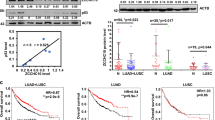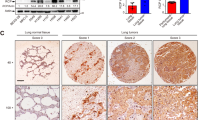Abstract
Cysteine-rich protein 61 (Cyr61) is a growth factor-inducible, immediate-early gene that has multifaceted activities in various cancers. In a previous study, we found that Cyr61 inhibited the growth of the H520 and H460 non-small-cell lung cancer (NSCLC) cell lines. In further studies, we now report that p53 plays a pivotal role in Cyr61-dependent cellular growth arrest. Blocking Cyr61 with a Cyr61 antibody resulted in the downregulation of expression of p53 and p21, as well as partially reversing the growth suppression of H520-Cyr61 cells. Proliferation of NSCLC cell lines (NCI-H157, H125, H1299), having a mutant p53, were not suppressed by Cyr61. Inhibition of wild-type p53, by either human papilloma virus type 16 E6 or a dominant-negative p53, resulted in the rescue of the growth suppression mediated by Cyr61 in the H520-Cyr61 cells. The enhanced levels of p21WAF1 and p130/RB2, in the Cyr61-expressing H520-Cyr61 cells, were also inhibited by blocking p53 showing that p21 and p130 were induced by p53 in these cells. In addition, levels of both c-myc and β-catenin increased in Cyr61 stably transfected H520 cells. Moreover, β-catenin was translocated into the nucleus in these cells. Inhibition of c-myc expression in the H520-Cyr61 cells with antisense c-myc resulted in their decreased levels of p53. Transfecting cells with a dominant-negative T-cell factor (TCF4), the specific inhibitor of the β-catenin/TCF4 complex, downregulated the expression of c-myc. Taken together, the data suggest that Cyr61 suppressed the growth of NSCLC cells by triggering a signal transduction pathway through β-catenin. In this pathway, Cyr61 activated the β-catenin/TCF4 complex, which promoted the expression of c-myc and the latter induced expression of p53, and p53 upregulated p21WAF1 and p130/RB2, resulting in growth arrest.
This is a preview of subscription content, access via your institution
Access options
Subscribe to this journal
Receive 50 print issues and online access
$259.00 per year
only $5.18 per issue
Buy this article
- Purchase on Springer Link
- Instant access to full article PDF
Prices may be subject to local taxes which are calculated during checkout






Similar content being viewed by others
References
Allan LA and Fried M . (1999). Oncogene, 18, 5403–5412.
Ashcroft M, Taya Y and Vousden KH . (2000). Mol. Cell Biol., 20, 3224–3233.
Babic AM, Kireeva ML, Kolesnikova TV and Lau LF . (1998). Proc. Natl. Acad. Sci. USA, 95, 6355–6360.
Behrens J, Jerchow BA, Wurtele M, Grimm J, Asbrand C, Wirtz R, Kuhl M, Wedlich D and Birchmeier W . (1998). Science, 280, 596–599.
Behrens J, von Kries JP, Kuhl M, Bruhn L, Wedlich D, Grosschedl R and Birchmeier W . (1996). Nature, 382, 638–642.
Ben-Ze’ev A and Geiger B . (1998). Curr. Opin. Cell Biol., 10, 629–639.
Bienz M . (1999). Curr. Opin. Genet. Dev., 9, 595–603.
Blackwood EM, Kretzner L and Eisenman RN . (1992). Curr. Opin. Genet. Dev., 2, 227–235.
Blagosklonny MV . (2000). FASEB J., 14, 1901–1907.
Bodner SM, Minna JD, Jensen SM, D’Amico D, Carbone D, Mitsudomi T, Fedorko J, Buchhagen DL, Nau NM and Gazdar AF . (1992). Oncogene, 7, 743–749.
Cadigan KM and Nusse R . (1997). Genes Dev., 11, 3286–3305.
Carroll JS, Prall OW, Musgrove EA and Sutherland RL . (2000). J. Biol. Chem., 275, 38221–38229.
Chen N, Chen CC and Lau LF . (2000). J. Biol. Chem., 275, 24953–24961.
Clevers H . (2000). Nat. Cell Biol., 2, E177–E178.
Cox RT and Peifer M . (1998). Curr. Biol., 8, R140–R144.
Damalas A, Ben-Ze’ev A, Simcha I, Shtutman M, Leal JF, Zhurinsky J, Geiger B and Oren M . (1999). EMBO J., 18, 3054–3063.
Damalas A, Kahan S, Shtutman M, Ben-Ze'ev A and Oren M . (2001). EMBO. J., 20, 4912–4922.
Dang CV . (1999). Mol. Cell Biol., 19, 1–11.
Danilkovitch-Miagkova A, Miagkov A, Skeel A, Nakaigawa N, Zbar B and Leonard EJ . (2001). Mol. Cell. Biol., 21, 5857–5868.
Debbas M and White E . (1993). Genes Dev., 7, 546–554.
Delcommenne M, Tan C, Gray V, Rue L, Woodgett J and Dedhar S . (1998). Proc. Natl. Acad. Sci. USA, 95, 11211–11216.
Deng C, Zhang P, Harper JW, Elledge SJ and Leder P . (1995). Cell, 82, 675–684.
el-Deiry WS, Harper JW, O’Connor PM, Velculescu VE, Canman CE, Jackman J, Pietenpol JA, Burrell M, Hill DE and Wang Y . (1994). Cancer Res., 54, 1169–1174.
el-Deiry WS, Tokino T, Velculescu VE, Levy DB, Parsons R, Trent JM, Lin D, Mercer WE, Kinzler KW and Vogelstein B . (1993). Cell, 75, 817–825.
Evan GI, Wyllie AH, Gilbert CS, Littlewood TD, Land H, Brooks M, Waters CM, Penn LZ and Hancock DC . (1992). Cell, 69, 119–128.
Giaccia AJ and Kastan MB . (1998). Genes Dev., 12, 2973–2983.
Grzeszkiewicz TM, Kirschling DJ, Chen N and Lau LF . (2001). J. Biol. Chem., 276, 21943–21950.
Gumbiner BM . (1996). Cell, 84, 345–357.
Harper JW, Adami GR, Wei N, Keyomarsi K and Elledge SJ . (1993). Cell, 75, 805–816.
Hart M, Concordet JP, Lassot I, Albert I, del los Santos R, Durand H, Perret C, Rubinfeld B, Margottin F, Benarous R and Polakis P . (1999). Curr. Biol., 9, 207–210.
He TC, Sparks AB, Rago C, Hermeking H, Zawel L, da Costa LT, Morin PJ, Vogelstein B and Kinzler KW . (1998). Science, 281, 1509–1512.
Hermeking H and Eick D . (1994). Science, 265, 2091–2093.
Hsu SC, Galceran J and Grosschedl R . (1998). Mol. Cell. Biol., 18, 4807–4818.
Huang S, Liu LN, Hosoi H, Dilling MB, Shikata T and Houghton PJ . (2001). Cancer Res., 61, 3373–3381.
Jedsadayanmata A, Chen CC, Kireeva ML, Lau LF and Lam SC . (1999). J. Biol. Chem., 274, 24317–24321.
Kemler R . (1993). Trends Genet., 9, 317–321.
Kern SE, Pietenpol JA, Thiagalingam S, Seymour A, Kinzler KW and Vogelstein B . (1992). Science, 256, 827–830.
Kireeva ML, Lam SC and Lau LF . (1998). J. Biol. Chem., 273, 3090–3096.
Kireeva ML, Mo FE, Yang GP and LauF LF . (1996). Mol. Cell Biol., 16, 1326–1334.
Kuerbitz SJ, Plunkett BS, Walsh WV and Kastan MB . (1992). Proc. Natl. Acad. Sci. USA, 89, 7491–7495.
Levine AJ . (1992). N. Engl. J. Med., 326, 1350–1352.
Levine AJ . (1997). Cell, 88, 323–331.
Lowe SW, Schmitt EM, Smith SW, Osborne BA and Jacks T . (1993). Nature, 362, 847–849.
Marcu KB, Bossone SA and Patel AJ . (1992). Annu. Rev. Biochem., 61, 809–860.
Marutani M, Tonoki H, Tada M, Takahashi M, Kashiwazaki H, Hida Y, Hamada J, Asaka M and Moriuchi T . (1999). Cancer Res., 59, 4765–4769.
Mitsudomi T, Steinberg SM, Nau MM, Carbone D, D’Amico D, Bodner S, Oie HK, Linnoila RI, Mulshine JL and Minna JD . (1992). Oncogene, 7, 171–180.
Morgan DO . (1995). Nature, 374, 131–134.
Munemitsu S, Albert I, Souza B, Rubinfeld B and Polakis P . (1995). Proc. Natl. Acad. Sci. USA, 92, 3046–3050.
Novak A, Hsu SC, Leung-Hagesteijn C, Radeva G, Papkoff J, Montesano R, Roskelley C, Grosschedl R and Dedhar S . (1998). Proc. Natl. Acad. Sci. USA, 95, 4374–4379.
Pilarsky CP, Schmidt U, Eissrich C, Stade J, Froschermaier SE, Haase M, Faller G, Kirchner TW and Wirth MP . (1998). Prostate, 36, 85–91.
Prives C . (1998). Cell, 95, 5–8.
Reisman D, Elkind NB, Roy B, Beamon J and Rotter V . (1993). Cell Growth Differ., 4, 57–65.
Riese J, Yu X, Munnerlyn A, Eresh S, Hsu SC, Grosschedl R and Bienz M . (1997). Cell, 88, 777–787.
Roy B, Beamon J, Balint E and Reisman D . (1994). Mol. Cell Biol., 14, 7805–7815.
Rubinfeld B, Albert I, Porfiri E, Fiol C, Munemitsu S and Polakis P . (1996). Science, 272, 1023–1026.
Sadot E, Simcha I, Iwai K, Ciechanover A, Geiger B and Ben-Ze’ev A . (2000). Oncogene, 19, 1992–2001.
Sampath D, Zhu Y, Winneker RC and Zhang Z . (2001). J. Clin. Endocrinol. Metab., 86, 1707–1715.
Scheffner M, Werness BA, Huibregtse JM, Levine AJ and Howley PM . (1990). Cell, 63, 1129–1136.
Seewaldt VL, Mrozek K, Dietze EC, Parker M and Caldwell LE . (2001). Cancer Res., 61, 616–624.
Serrano M, Lin AW, McCurrach ME, Beach D and Lowe SW . (1997). Cell, 88, 593–602.
Shi Y, Glynn JM, Guilbert LJ, Cotter TG, Bissonnette RP and Green DR . (1992). Science, 257, 212–214.
Shih IM, Yu J, He TC, Vogelstein B and Kinzler KW . (2000). Cancer Res., 60, 1671–1676.
Smith ML, Chen TT, Zhan Q, Bae I, Chen CY, Gilmer TM, Kastan MB, O’Connor PM and Fornace Jr AJ . (1994). Science, 266, 1376–1380.
Stiegler P and Giordano A . (1999). Anal. Quant. Cytol. Histol., 21, 363–366.
Tan C, Costello P, Sanghera J, Dominguez D, Baulida J, de Herreros AG and Dedhar S . (2001). Oncogene, 20, 133–140.
Tavtigian SV, Zabludoff SD and Wold BJ . (1994). Mol. Biol. Cell, 5, 375–388.
Tong X, Xie D, O’Kelly J, Miller CW, Muller-Tidow C and Koeffler HP . (2001). J. Biol. Chem., 276, 47709–47714.
Tsai MS, Hornby AE, Lakins J and Lupu R . (2000). Cancer Res., 60, 5603–5607.
van de Wetering M, Cavallo R, Dooijes D, van Beest M, van Es J, Loureiro J, Ypma A, Hursh D, Jones T, Bejsovec A, Peifer M, Mortin M and Clevers H . (1997). Cell, 88, 789–799.
Waikel RL, Kawachi Y, Waikel PA, Wang XJ and Roop DR . (2001). Nat. Genet., 28, 165–168.
Wang Y, Blandino G, Oren M and Givol D . (1998). Oncogene, 17, 1923–1930.
Weinberg RA . (1995). Cell, 81, 323–330.
Werness BA, Levine AJ and Howley PM . (1990). Science, 248, 76–79.
Willert K and Nusse R . (1998). Curr. Opin. Genet. Dev., 8, 95–102.
Woods DB and Vousden KH . (2001). Exp. Cell. Res., 264, 56–66.
Xie D, Miller CW, O’Kelly J, Nakachi K, Sakashita A, Said JW, Gornbein J and Koeffler HP . (2001). J. Biol. Chem., 276, 14187–14194.
Xiong Y, Hannon GJ, Zhang H, Casso D, Kobayashi R and Beach D . (1993). Nature, 366, 701–704.
Yost C, Torres M, Miller JR, Huang E, Kimelman D and Moon RT . (1996). Genes Dev., 10, 1443–1454.
Yu K, Ravera CP, Chen YN and McMahon G . (1997). Cell Growth Differ., 8, 731–742.
Zeng L, Fagotto F, Zhang T, Hsu W, Vasicek TJ, Perry 3rd WL, Lee JJ, Tilghman SM, Gumbiner BM and Costantini F . (1997). Cell, 90, 181–192.
Zindy F, Eischen CM, Randle DH, Kamijo T, Cleveland JL, Sherr CJ and Roussel MF . (1998). Genes Dev., 12, 2424–2433.
Acknowledgements
This work was supported in part by the NIH Lung Spore grant CA90388 as well as support from the Parker Hughes Trust. HPK is the recipient of the Goodson Endowed Chair in Oncology Research and is a member of the Jonsson Cancer Center and the Molecular Biology Institute of UCLA.
Author information
Authors and Affiliations
Corresponding author
Rights and permissions
About this article
Cite this article
Tong, X., O'Kelly, J., Xie, D. et al. Cyr61 suppresses the growth of non-small-cell lung cancer cells via the β-catenin–c-myc–p53 pathway. Oncogene 23, 4847–4855 (2004). https://doi.org/10.1038/sj.onc.1207628
Received:
Revised:
Accepted:
Published:
Issue Date:
DOI: https://doi.org/10.1038/sj.onc.1207628
Keywords
This article is cited by
-
MITF is a driver oncogene and potential therapeutic target in kidney angiomyolipoma tumors through transcriptional regulation of CYR61
Oncogene (2021)
-
Forkhead box K1 facilitates growth of papillary thyroid carcinoma cells by regulating connective tissue growth factor expression
Human Cell (2021)
-
Circ-GLI1 promotes metastasis in melanoma through interacting with p70S6K2 to activate Hedgehog/GLI1 and Wnt/β-catenin pathways and upregulate Cyr61
Cell Death & Disease (2020)
-
c-Myc promotes tubular cell apoptosis in ischemia-reperfusion-induced renal injury by negatively regulating c-FLIP and enhancing FasL/Fas-mediated apoptosis pathway
Acta Pharmacologica Sinica (2019)
-
Molecular signatures for CCN1, p21 and p27 in progressive mantle cell lymphoma
Journal of Cell Communication and Signaling (2019)



